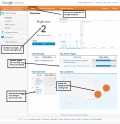How to Interpret Time On Site, Time On Page, & Bounce Rate in Google Analytics
To find out how successful your website is at attracting and keeping visitors, you can use a free tool like Google Analytics. Time On Page, Time On Site and Bounce Rate are a few of the Google Analytics web metrics that you should be concerned about. Time On Site refers to how long visitors stay on your website. Time On Page refers to the time spent on a specific web page. Bounce Rate refers to the percentage of visitors who quickly leave the website.
If you own a website, you can sign up for a free account with Google Analytics to find these web metrics. Various metrics offered will give you an idea of how effective your website is at getting and keeping visitors. If you have a high Bounce Rate and low Time On Site, it may indicate some problems with your site or content.

Interpreting the Results
Some potential causes of a high bounce rate or low Time On Site could be poorly written content, inappropriate webpage titles and keywords, slow page loading times, or confusing navigation.
Some websites use titles and keywords that don’t properly relate to the site’s content to draw in visitors. If visitors enter your site and see that you don’t offer what they are looking for, they will quickly leave. That will lead to a very low Time On Site.
A website may have high Time On Page and high Time On Site but still rank low in Google searches. If you have a lot of unoriginal content that is duplicated all over the web, you may still rank low regardless of how many visitors you receive or how long they stay. Google loves original content.
A low Time On Page doesn't necessarily mean that the content is not good or interesting. It could simply indicate that people quickly find whatever they need. For example, if you have a webpage that provides facts about Japan, someone looking for the population of Tokyo may have little reason to stay on the page once they find that information. Consider how to keep visitors engaged once they click on a page.
Some Limitations to Consider
There are some limitations in how these web metrics work. If a visitor enters your website, spends an hour on the same page and then shuts down their browser, Time On Site will be recorded as zero. The problem is that Time On Site and Time On Page require more than one click. If a visitor enters on Page A and then clicks to Page B after two minutes, the time spent on Page A is recorded.
However, if a visitor spends 10 minutes on Page A and either closes their browser or navigates away to a different site, that time isn’t recorded because there was no second click within the website. You need to keep these limitations in mind when trying to makes sense of web site traffic analysis.
Effect on Google Ranking
So, what do all of these web metrics mean? Google takes into account so many factors when ranking a page, you shouldn't automatically assume that low Time On Page, low Time On Site, or a high Bounce Rate will lead to a low Google ranking and the opposite a high Google ranking. You have to be cautious in how you interpret results.
But if your website rankings are bad, Google Analytics is one tool that may help you determine where potential problems may be. If you have a low Google ranking, combined with low Time On Page, low Time On Site, and High Bounce rate metrics, there is probably something seriously wrong with your website. Some things to consider are:
- Page loading time - if your pages load slowly, visitors may quickly navigate away. Google Analytics provides page loading time information
- Content - make sure your content is well written, organized, easy to understand, and grammatically correct
- Website navigation - your website should be easy to navigate. If visitors don't know how to find the information they need they may quickly leave. Avoid complex multi-level menus
- Titles should match content - make sure your titles match your content. There is no point in drawing in visitors when you don't offer what they are looking for
- Professional look - your website should look professional. A website that looks "home-made" might turn off some visitors
You can use a free tool like Search Engine Genie to figure out where your website ranks for various keywords in several search engines, including Google.
This content reflects the personal opinions of the author. It is accurate and true to the best of the author’s knowledge and should not be substituted for impartial fact or advice in legal, political, or personal matters.
© 2011 LT Wright








